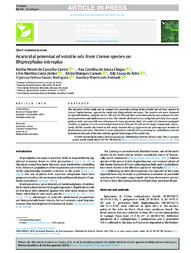Acaricidal potential of volatile oils from Croton species on Rhipicephalus microplus.
Acaricidal potential of volatile oils from Croton species on Rhipicephalus microplus.
Author(s): CASTRO, K. N. de C.; CHAGAS, A. C. de S.; COSTA-JÚNIOR, L. M.; CANUTO, K. M.; BRITO, E. S. de; RODRIGUES. T. H. S.; ANDRADE, I. M. de
Summary: The objective of this study was to evaluate the acaricidal activity of the volatile oils of three species of Croton, Euphorbiaceae, against the cattle tick Rhipicephalus microplus. The volatile oils were obtained by hydrodistillation, analyzed by GC?MS and GC-FID and their acaricidal activity was evaluated by the larval packettest and adultimmersion test. The volatile oils from Croton conduplicatus Kunth, Croton pulegiodorus Baill., and two different collections of Croton grewioides Baill. (CG1 and CG2) showed eucalyptol (24.09%), p-cymene (23.13%) and methyl chavicol (83.59% and 95.38%) as the major compounds, respectively. All the volatile oils tested in this study showed efficacy against larvae and engorged females of Rhipicephalus microplus. Therefore, Croton pulegiodorus volatile oil is promising for a potential acaricidal formulation because of the best activity against both stages of the cattle tick.
Publication year: 2019
Types of publication: Journal article
Observation
Some of Embrapa's publications are published as ePub files. To read them, use or download one of the following free software options to your computer or mobile device. Android: Google Play Books; IOS: iBooks; Windows and Linux: Calibre.
Access other publications
Access the Agricultural Research Database (BDPA) to consult Embrapa's full library collection and records.
Visit Embrapa Bookstore to purchase books and other publications sold by Embrapa.

